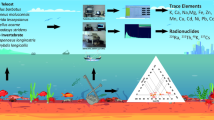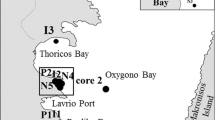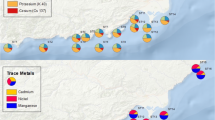Abstract
Environmental preservation of Ha Long Bay, a UNESCO World Heritage Site, is a national priority for Vietnam. Coal mining is growing in the region with interim coal stockpiling on the shore by the maritime harbour in Ha Long Bay. Due to the presence of radionuclides in coal, radioactivity analyses were carried out for the first time in coastal samples to assess the radionuclide levels in Ha Long Bay. Samples of coal, sediments, molluscs, shrimp, and fish were collected from the Bay site and analyzed for U, Th, 226Ra, 210Pb and 210Po by alpha spectrometry, and for 40K, 228Ra and 137Cs by gamma spectrometry. Radionuclide concentrations in sediments ranged from 21 to 43 Bq kg−1 dry weight (dw) for 238U, from 14 to 35 Bq kg−1 dw for 226Ra, and from 25 to 122 Bq kg−1 dw for 210Pb and 210Po. Radionuclide concentrations in marine biota were comparable to data reported for other coastal areas. It was concluded that despite discharges of the long-lasting coal mining industry in the area, no significant enhancement of radioactivity occurred in biota of Ha Long Bay. Although at naturally-occurring levels, 210Po concentrations in biota were remarkably higher than concentrations of other radionuclides and showed a clear trend of biomagnification with increasing trophic levels, contrasting with the discrimination of U, Th and other radionuclides in the marine food chain. Radionuclides of artificial origin, namely 137Cs, were present at very low level. Current radionuclide levels in marine biota do not represent a radiation hazard for sea food consumers.
Highlights
-
Coal mines discharges into the Bay enhanced U and Th levels in sediments
-
Radioactivity in marine biota from the Bay was comparable to biota from other seas.
-
Po was biomagnified in the marine food chain while U, Th, Ra, Pb were discriminated.




Similar content being viewed by others
Data Availability
All relevant data sets are included in the manuscript.
Code Availability
Not applicable.
References
ABC News (2015) Flooded Vietnam coal mines leaking toxic slurry into World Heritage-listed Ha Long Bay: environmentalists. Available at: https://www.abc.net.au/news/2015-08-01/heavy-rain-floods-vietnam-coal-mines-threatening-ha-long-bay/6665570?nw=0. Accessed 15 Sept 2020
Anh LT (2015) Situation analysis of the water quality of Ha Long Bay, Quang Ninh Province, Viet Nam: A social study from tourism businesses’ perspectives. Gland, Switzerland: IUCN, 46pp. Available at: https://portals.iucn.org/library/sites/library/files/documents/2015-065.pdf. Accessed 15 Sept 2020
Atwood DA (ed) (2010) Radionuclides in the environment. Encyclopedia of inorganic chemistry. Wiley, New York
Carvalho FP (1995) 210Pb and 210Po in sediments and suspended matter in the Tagus estuary, Portugal. Local enhancement of natural levels by wastes from phosphate ore processing industry. Sci Total Environ 159:201–214. https://doi.org/10.1016/0048-9697(95)04332-U
Carvalho FP (2011) Polonium (210Po) and lead (210Pb) in marine organisms and their transfer in marine food chains. J Environ Radioact 102:462-472. https://doi.org/10.1016/j.jenvrad.2010.10.011
Carvalho FP (2018) Radionuclide concentration processes in marine organisms: A comprehensive review. J Environ Radioact 186:124–130. https://doi.org/10.1016/j.jenvrad.2017.11.002
Carvalho FP, Oliveira JM (2007) Alpha emitters from uranium mining in the environment. J Radioanal Nucl Chem 274:167–174. https://doi.org/10.1007/s10967-006-6914-3
Carvalho FP, Oliveira JM (2008) Radioactivity in marine organisms from Northeast Atlantic Ocean. In: The Natural Radiation Environment (NRE VIII). Paschoa AS, Steinhauesler F (eds) AIP Conference Proceedings 1034. American Institute of Physics, Melville. New York, USA. pp 387-392. https://doi.org/10.1063/1.2991251
Carvalho FP, Oliveira JM (2009) Performance of alpha spectrometry in the analysis of uranium isotopes in environmental and nuclear materials. J Radioanal Nucl Chem 281:591–596. https://doi.org/10.1007/s10967-009-0046-2
Carvalho F, Fernandes S, Fesenko S, Holm E, Howard B, Martin P, Phaneuf M, Porcelli D, Pröhl G, Twining J (2017) The environmental behaviour of polonium. IAEA technical report series no. 484. International Atomic Energy Agency, Vienna, 255 pp. Available at: https://www-pub.iaea.org/MTCD/Publications/PDF/D484_web.pdf. Accessed 1 July 2021
Cerrano C, Azzini F, Bavestrello G, Calcinai B, Pansini M, Sarti M, Thung D (2006) Marine lakes of karst islands in Ha Long Bay (Vietnam). Chem Ecol 22(6):489–500. https://doi.org/10.1080/02757540601024835
Cherry RD, Heyraud M (1981) Polonium-210 Content of marine shrimp: variation with biological and environmental factors. Mar Biol 65:165–175. https://doi.org/10.1007/BF00397082
Connan O, Germain P, Solier L, Gouret G (2007) Variations of 210Po and 210Pb in various marine organisms from western English Channel: Contribution of 210Po to the radiation dose. J Environ Radioact 97(2–3):168–188. https://doi.org/10.1016/j.jenvrad.2007.04.004
Dai S, Finkelman RB (2018) Coal as a promising source of critical elements; Progress and future prospects. Int J Coal Geol 186:155–164. https://doi.org/10.1016/j.coal.2017.06.005
Desideri D, Meli MA, Roselli C (2010) A biomonitoring study: 210Po and heavy metals in marine organisms from the Adriatic Sea (Italy). J Radioanal Nucl Chem 285:373–382. https://doi.org/10.1007/s10967-010-0541-5
Drogue C, Cat NN, Dazy J (2000) Geological factors affecting the chemical characteristics of the thermal waters of the carbonate karstified aquifers of Northern Vietnam. Hydrol Earth Sci Syst 4(2):332–340. https://doi.org/10.5194/hess-4-332-2000
EcoWatch (2015) Toxic floods from coal mines and power plants hit Vietnam’s Ha Long Bay World Heritage Site. Available at: https://www.ecowatch.com/toxic-floods-from-coal-mines-and-power-plants-hit-vietnams-ha-long-bay-1882080179.html. Accessed 15 Sept 2020
EU: European Union (2013) Council Directive 2013/59/Euratom of 5 December 2013 laying down basic safety standards for protection against the dangers arising from exposure to ionising radiation, and repealing Directives 89/618/Euratom, 90/641/Euratom, 96/29/Euratom, 97/43/Euratom and 2003/122/Euratom. Off J Eur Union L13/1, 17-1-2014
Fonollosa E, Peñalver A, Aguilar C, Borrull F (2017) Bioaccumulation of natural radionuclides in molluscs from the Ebro Delta area. Environ Sci Pollut Res 24:208–214. https://doi.org/10.1007/s11356-016-7783-x
Giuliani S, Bellucci L, Nhon DH (2019) The coast of Vietnam: Present status and future challenges for sustainable development. In: Sheppard C (ed) World Seas: An Environmental Evaluation. Volume II: The Indian Ocean to the Pacific pp. Academic, New York, pp 415–436
Hieu VD, Nam BX, An LH (2012) The effect of mining exploitation on environment in Vietnam. Conference: China-ASEAN Mining Cooperation Forum and Exhibition 2012. Available at: https://www.researchgate.net/publication/234055847. Accessed 23 Sept 2020
IAEA: International Atomic Energy Agency (2004) Sediment distribution coefficients and concentration factors for biota in the marine environment. Technical Reports Series No. 422. IAEA, Vienna, 95p. Available at: https://www.iaea.org/publications/6855/sediment-distribution-coefficients-and-concentration-factors-for-biota-in-the-marine-environment. Accessed 1 July 2021
IAEA: International Atomic Energy Agency (2010) Handbook of parameter values for the prediction of radionuclide transfer in terrestrial and freshwater environment. Technical Reports Series No. 472. IAEA, Vienna, 194p. Available at: https://www.iaea.org/publications/8201/handbook-of-parameter-values-for-the-prediction-of-radionuclide-transfer-in-terrestrial-and-freshwater-environments. Accessed 1 July 2021
IAEA: International Atomic Energy Agency (2014) Radiation protection and safety of radiation sources: international basic safety standards, IAEA Safety Standards Series No. GSR Part 3, IAEA, Vienna, 436 p. Available at: https://www-pub.iaea.org/MTCD/publications/PDF/Pub1578_web-57265295.pdf. Accessed 1 July 2021
Ivanovich M, Harmon RS (eds) (1992) Uranium-series disequilibrium: applications to earth, marine, and environmental sciences, 2nd edn. Clarendon Press, Oxford
Kiliç Ö, Murat B, Gözel F, Carvalho FP (2014) Radioactivity levels in mussels and sediments of the Golden Horn by the Bosphorus Strait, Marmara Sea. Mar Poll Bull 86(1–2):555–561. https://doi.org/10.1016/j.marpolbul.2014.06.033
Kiliç O, Murat B¸ Onur G, Narin S, Carvalho FP (2018) 210Po and 210Pb in fish from northern Aegean Sea and radiation dose to fish consumers. J Radioanal Nucl Chem 318:1189–1199. https://doi.org/10.1007/s10967-018-6216-3(0123456789
Long Q, Nguyen V, Thang DV, Hau DT, Oanh NT (2011) Marine environment monitoring for Environmental Impact Assessment for the Program of Nuclear Power Introduction into Vietnam. Report to the Ministry of Sci. Technology of Vietnam. Ha Noi, Mar 2011. 21p. (In Vietnamese)
Magill J, Galy J (2005) Radioactivity, radionuclides, radiation. Springer, Berlin
Mari X, Guinot B, Chu VT, Brune J, Lefebvre JP, Angia Sriram PR, Raimbault P, Dittmar T, Niggemann J (2019) Biogeochemical impacts of a black carbon wet deposition event in Ha Long Bay, Vietnam. Front Mar Sci 6:185. https://doi.org/10.3389/fmars.2019.00185
Michalik B (2017) NORM contaminated area identification using radionuclides activity concentration pattern in a soil profile. J Environ Radioact 173:102–111. https://doi.org/10.1016/j.jenvrad.2016.11.035
Mustafin MG, Son TT, Hung TM (2019) Comprehensive impact assessment development of the coal field Cam Pha in Vietnam to the coastal territory. IOP Conf Ser: Mater Sci Eng 698:055014. https://doi.org/10.1088/1757-899X/698/5/055014
Nhan DD, Carvalho FP, Ha NT, Long NQ, Thuan DD, Fonseca H (2012) Radon (222Rn) concentration in indoor air near the coal mining area of Nui Beo, North of Vietnam. J Environ Radioact 110:98–103. https://doi.org/10.1016/j.jenvrad.2012.02.008
Oliveira JM, Carvalho FP (2006) a sequential extraction procedure for determination of uranium, thorium, radium, lead and polonium radionuclides by alpha spectrometry in environmental samples. In: Proceedings of the 15th Radiochemical Conference. Czechoslovak J Phys 56(Suppl. D): 545-555. Available at: http://projects.ctn.tecnico.ulisboa.pt/FPCarvalho/OliveiraeCarvalho2006.pdf. Accessed 1 July 2021
Pham MK, Benmansour M, Carvalho FP, Chamizo E, Degering D, Engeler C, Gascó C, Gwynn JP, Harms AV, Hrnecek E, Ibanez FL, Ilchmann C, Ikaheimonen T (2014) Certified Reference Material IAEA-446 for radionuclides in Baltic Sea seaweed. Appl Radiat Isot 87:468–474. https://doi.org/10.1016/j.apradiso.2013.11.013
Pham MK, van Beek P, Carvalho FP, Chamizo E, Degering D, Engeler C, Gascó C, Gurriaran R, Hanley O, Harms AV, Herrmann J, Hult M, Ikeuchi Y, Ilchmann C, Kanisch G, Kis-Benedek G, Kloster M, Laubenstein M, Llaurado M, Mas JL, Nakano M, Nielsen SP, Osvath I, Povinec PP, Rieth U, Schikowski J, Smedley PA, Suplinska M, Sýkora I, Tarjan S, Varga B, Vasileva E, Zalewska T, Zhou W (2016) Certified reference materials for radionuclides in Bikini Atoll sediment (IAEA-410) and Pacific Ocean sediment (IAEA-412). Appl Radiat Isot 109:101–104. https://doi.org/10.1016/j.apradiso.2015.11.041
Pociask-Karteczka J, Jasinska M, Mietelski JW (1997) The influence of radionuclides released by Silesian coal mine activity on the natural environment in the Upper Vistula basin (Poland). Freshwater Contamination (Proceedings of Rabat Symposium S4, April-May 1997). IAHS Publ. no. 243. Available at: http://hydrologie.org/redbooks/a243/iahs_243_0103.pdf. Accessed 23 Sept 2020
Povinec PP, Pham MK, Sanchez-Cabeza JA, Barci-Funel G, Bojanowski R, Boshkova T, Burnett WC, Carvalho F, Chapeyron B, Cunha IL, Dahlgaard H, Galabov N, Field LK, Gastaud J, Geering JJ, Gomez IF, Green N, Hamilton T, Ibanez FL, Ibn MajahShow M, John M, Kanisch G, Kenna TC, Kloster M, Korun M, Liong Wee Kwong L, la Rosa J, Lee SH, Levy-Palomo I, Malatova M, Maruo Y, Mitchell P, Murciano IV, Nelson R, Nouredine A, Oh JS, Origioni B, le Petit G, Petterson HBL, Reineking A, Smedley PA, Suckow A, van der Struijs TDB, Voors PI, Yoshimizu K, Wyse E (2007) Reference material for radionuclides in sediment, IAEA-384 (Fangataufa Lagoon sediment). J Radioanal Nucl Chem 273:383–393. https://doi.org/10.1007/s10967-007-6898-4
Prachiti PK, Manikyamba C, Prakash K, Singh V, Balaram G, Lakshminarayana K, Raju MP, Singh MS, Kalpana M, Mukesh A (2011) Geochemical systematics and precious metal content of the sedimentary horizons of Lower Gondwanas from the Sattupalli coal field, Godavari Valley, India. Int J Coal Geol 88:83–100. https://doi.org/10.1016/jcoal201108005
Sheppard C (ed) (2019) World seas: an environmental evaluation. Volume II: The Indian Ocean to the Pacific. Academic, London
Trang CTT, Thung DC, Nam LV, Kha PT, Bach NV, Ngoc DH (2020) Assessment of sea water quality in some limestone islands and archipelagos areas, Vietnam. VNU J Sci: Earth Environ Sci 36(1):70–78. https://doi.org/10.25073/2588-1094/vnuees.4556
Uddin S, Aba A, Fowler SW, Behbehania M, Ismaeel A, Al-Shammari H, Alboloushi A, Mietelski JW, Al-Ghadban A, Al-Ghunaim A, Khabbaz A, Alboloushi O (2015) Radioactivity in the Kuwait marine environment - Baseline measurements and review. Marine Poll Bull 100:651–661. https://doi.org/10.1016/j.jenvrad.2016.08.021
USGS: United States Geological Survey (1997) Radioactive Elements in Coal and Fly Ash: Abundance, Forms, and Environmental Significance. US Geological Survey Fact Sheet FS-163-97. Available at: https://pubs.usgs.gov/fs/1997/fs163-97/FS-163-97.pdf. Accessed 21 Sept 2021
Van TT, Ba LT, Nhan DD, Bui NHQ, Cam D, Hung LV (2019) Estimation of radionuclide concentrations and average annual committed effective dose due to ingestion for the population in the Red River delta. Vietnam Environ Manag 63:444–454. https://doi.org/10.1007/s00267-018-1007-8
Wang X, Feng Q, Sun R, Liu G (2015) Radioactivity of natural nuclides (40K, 238U, 232Th, 226Ra) in coals from eastern Yunnan, China. Minerals 5(4):637–646. https://doi.org/10.3390/min5040513
Wysocka M, Chałupnik S, Chmielewska I, Janson E, Radziejowski W, Samolej K (2019) Natural radioactivity in Polish coal mines: An attempt to assess the trend of radium release into the environment. Mine Water Environ 38:581–589. https://doi.org/10.1007/s10230-019-00626-0
Zampieri C, Trotti F, Andreoli F, Ballarin Denti A (2008) NORM in the Italian tile and refractory industries. In: Proceedings of NORM V Conference. IAEA Proceedings Series, International Atomic Energy Agency, Vienna. pp.141-148. Available at: https://inis.iaea.org/search/search.aspx?orig_q=RN:40020652. Accessed 1 July 2021
Funding
Supported by the participating institutes, identified as author’s affiliations and addresses.
Author information
Authors and Affiliations
Contributions
All authors contributed to the study conception and design. Material preparation, data collection and analysis were performed by FPC, DDN, JMO, NQL, DDT, MM, MS. FPC wrote the first draft of the manuscript and all authors commented on previous versions of the manuscript. All authors read and approved the final manuscript.
Corresponding author
Ethics declarations
Conflicts of Interest/Competing Interests
None.
Ethics Approval
Not applicable (no experiments with animals or humans).
Consent to Participate
Not applicable.
Consent for Publication
Not applicable.
Additional information
Publisher’s Note
Springer Nature remains neutral with regard to jurisdictional claims in published maps and institutional affiliations.
Rights and permissions
About this article
Cite this article
Carvalho, F.P., Nhan, D.D., Oliveira, J.M. et al. Environmental Radioactivity in the Marine Environment of Ha Long Bay, North Vietnam, and Biomagnification of Polonium. Environ. Process. 8, 1359–1378 (2021). https://doi.org/10.1007/s40710-021-00545-9
Received:
Accepted:
Published:
Issue Date:
DOI: https://doi.org/10.1007/s40710-021-00545-9




